1966 Mustang, 289-4V
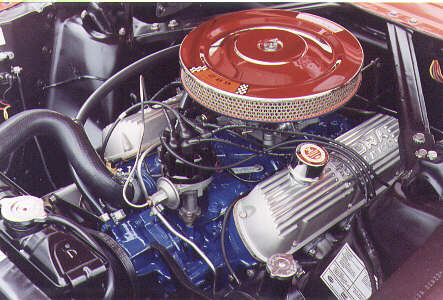
|
|
||||||||||||||||||||||||||||
|
The Ford V-8 Engine Workshop 90° V Small Block 221, 255, 260, 289, 289 HP, 302, 351W, 5.0 HO |
1966 Mustang, 289-4V

|
|
||||||||||||||||||||||||||||
| Introduced with the 221 in 1962 for the Fairlane, this small block is Ford's first modern lightweight engine. The next was the 429 Big Block. Interestingly, 221 cubic inches was also the displacement of the very first Ford Flathead V-8, built in 1932. |
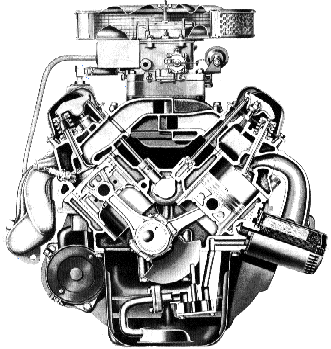
|
| A very compact design, the small block engine utilizes a thin-wall block casting not extended below the crankshaft centerline. Expanded to include the 260, 289, and 302, the engine family has provided power for most of Fords model lineup. Cylinder bore spacing is 4.38", the same as the Cleveland family. The small block is externally one of the smallest V-8 engines made, and total engine weight is around 460 lbs. The 289 was produced from 1963 to 1968. | |
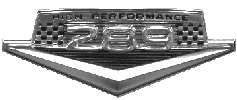
|
In 1963 Ford released the 289 High Performance which produced 271 BHP @ 6000 RPM. |
|
The 289 HP features a high nodularity cast iron crankshaft, Brinell hardness
tested to ensure quality. To prevent 4th order harmonic vibrations from
destroying the crankshaft at higher RPM, a special vibration damper was used
with an add-on counterweight within the timing cover.
Somewhat stronger connecting rods with 3/8" bolts, thicker main bearing caps,
solid lifter cam, screw-in rocker arm studs, machined valve spring seats,
forged steel exhaust valves, a dual point mechanical advance distributor,
and better flowing exhaust manifolds round out the package.
Those fitted to Shebly GT 350 cars rated at
306 HP also featured a high rise aluminum intake manifold and Tri-Y headers.
In 1968, the 289 was stroked 1/8" to form the 302. Block deck height and piston compression height remained the same. Shorter connecting rods made up the difference in the stroke. Some 302 blocks cast in Mexico have thicker, 289 HP style bearing caps. These were supposedly made with a higher nickel content alloy. Folklore claims these to be beefier than other blocks. On my bathroom scale a 1970 dated Mexican block weighed within 1/2 a pound of a regular 1970 302 block. That must be some lean beef.
Identified by casting numbers C8AM-B, 75ZY-AA, D1ZM-AA, among others, these blocks may be spotted by the "Hecho En Mexico" cast in the lifter valley. An extra unmachined boss protruding from the front of the driver's side cylinder bank can be easily spotted at the junkyard. |
|
| Small block reciprocating assemblies have some balance. The compact lightweight crankshaft itself does not carry enough counterweights to achieve zero balance. Extra counterweighting is cast into the flywheel and harmonic balancer bring the entire assembly into neutral balance. Early engines use 28.2 oz.-in. external balance, while 1982 and later engines use 50 oz.-in. flywheel and 34 oz.-in. damper external balance. All 351W engines use the early style 28.2 oz.-in. external balance. |
| Five different rocker arm alignment schemes have been used on small block engines. | |
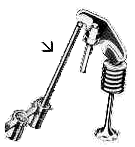
|
Rocker arm with close-tolerance pushrod slot
289 engines built before mid-1966 and all 289 HiPer engines use a conventional stud mounted rocker arm. The rocker arm is held in alignment with the valve stem by a close tolerance pushrod slot machined into the cylinder head. These engines use hardened pushrods. This scheme is fully adjustable and may be used successfully with mechanical cams. |
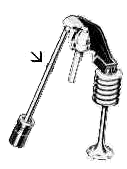
|
Rail-type rocker arm with loose fit pushrod hole
289 engines built after mid-1966 and 302 engines use a rail-type rocker arm. These rocker arms have ears that extend downward, forming a rail or channel over the valve stem. This rail maintains proper alignment. The pushrod passes through a loose tolerance hole in the cylinder head, resulting in a cheaper assembly. At high RPM, however, these rockers can jump the track, loosing alignment with the valve stem and resulting in potentially serious engine damage. These engines do not require hardened pushrods. This scheme was fully adjustable until 1970 when the studs were changed to incorporate a positive stop. The rocker arm nut is no longer used to adjust the valve clearance. Rather it is simply tightened down. Longer or shorter pushrods are selected to adjust the clearance. Since these are non-adjustable they can not be used with mechanical cams. |
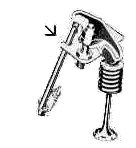
|
Rocker arm with screw-in stud and pushrod guide plate
Most high performance applications will not work with rail type rockers. High valve spring loads and high RPM operation can pull the pressed-in rocker studs right out of the cylinder head. Some people have used roll-pins to hold the studs securely in the heads, but the best solution is to modify the heads to use screw-in rocker studs and stamped steel pushrod guide plates. |
| Image coming soon. |
Pedistal mount rocker arm
Later production small block engines use a stamped steel rocker arm with a cylindrical seat and fulcrum. The fulrum has a built-in pedistal and bolts down to the cylinder head. Small stamped steel rails, looking like channels, sit under pairs of pedistals and control their alignment. This scheme worked without guide plates or hardened pushrods. |
| Image coming soon. |
Aluminum roller rocker arm
1993 5.0L Cobra engine feature diecast aluminum roller rockers. |
| Be sure to check out the Boss 302 article! |
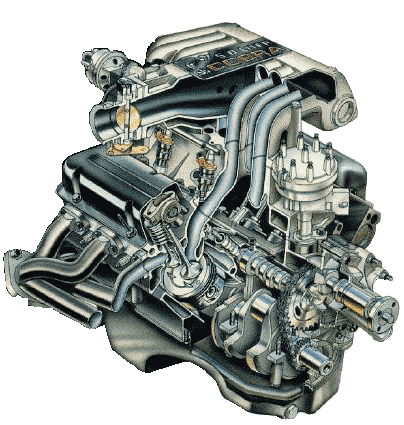
|
In the early '80s the horsepower wars were back. Ford's entry in this race was the new Fox chassis based Mustang powered by the 5.0 HO. |
|
Fed initially by a 2V carburetor in 1982, followed by a Holley 4V carburetor,
later by speed-density fuel injection, and ultimately by
a mass airflow injection system, the 5.0 inched its way up from around 157 HP in 1982 to 225 HP in 1987.
These engines feature roller tappet camshafts and factory
short-tube headers from 1985 on.
The 1993 5.0 Cobra featured SVO GT-40 heads and intake manifold, better flowing exhaust, and a recalibrated EEC-IV computer. 235 HP.
|
|

|
The 351 Windsor, built from 1969 to 1996, adds 0.5" to the stroke of the 302. It is of considerably stouter construction. Engine weight is 510 lbs. The 351W was designed as a long-stroke replacement for the 302 in passenger car use. It later served as a truck and marine engine through 1996. |
|
To avoid very short connecting rods and excessive piston side loads,
the 351W uses a taller block than the 289/302, 9.480" (1969/70) and 9.503" (1971/96).
The crankshaft uses very large 3.00" main journals, shared with the 400M. 2.311" rod journals
are shared with the 351C. The same 28 oz.-in. external balance is used as found on the 289/302 and
351C.
Before 1976, the heads feature larger valves than the 289/302 and provide a simple bolt-on horsepower upgrade. 351W exhaust manifolds, similar in design to those used on the 289 Hi Perf, also flow more freely than standard 289/302 manifolds. |
|
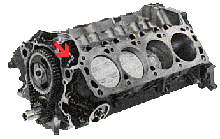 |
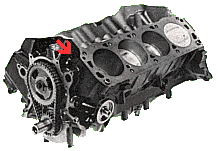 |
| 302 Short Block | 351W Short Block |
|
Notice the increased height between the timing cover gasket surface and the top of the block
on the 351W shown at the right below. The increased deck height can be seen at the arrows pointing
between the driver's side water inlet and the deck.
Another way to tell the 351W apart from the 289/302 in most cases is the number of intake
manifold to cylinder head bolts. The 289/302 has 12, the early 351W (pre 1976) has 16.
|
|
| Modified: |